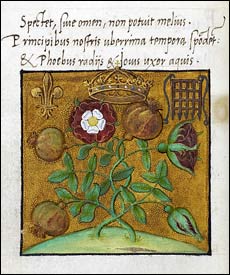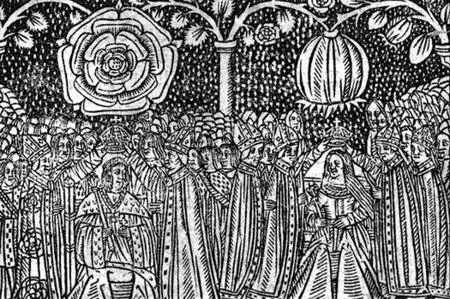
Henry VIII became King on the 21st April 1509, on the death of his father, Henry VII, but he did not get crowned until 24th June 1509, thirteen days after his marriage to Catherine of Aragon, daughter of Isabel I of Castile and Ferdinand II of Aragon.
Henry decided that he and his Queen would have a joint coronation and that this was to be their big event, rather than their wedding which was a rather low key and private affair at Greenwich Palace. There is no denying that their coronation was a lavish and very public event, perhaps a bit like this year’s Royal Wedding!
I have rewritten last year’s coronation article, adding in more details – enjoy!
The Lead-up to the Coronation
Celebrations began on the on the 21st June when Henry rode from Greenwich to the Tower of London to spend the time before his coronation in the Royal Palace there, as was customary for monarch. There, on the night of the 22nd June, various royal favourites were created Knights of the Bath at a special ceremony.
On Saturday 23rd June, the eve of the coronation, Henry and his new queen, Catherine of Aragon, processed through London, from the Tower to Westminster. The procession started at 4pm and consisted of the Knights of the Bath dressed in splendid blue gowns followed by Edward Stafford, Duke of Buckingham, who had been made Constable of England for the day and was richly dressed and carrying a silver baton to denote his special office, followed by the King.
The Chronicler Edward Hall describes how the streets were hung with tapestries and arras, “and the greate parte, of the South side of Chepe, with clothe of gold, and some parte of Cornehill also.” The young King wore a robe of crimson velvet, trimmed with ermine, a jacket of cloth of gold decorated with diamonds, rubies, emeralds, pearls and other precious stones. His horse was dressed with ermine and cloth-of-gold and the canopy held over him by the four barons of the Cinque Ports was also made of cloth-of-gold. Following Henry came his master of the horse, Sir Thomas Brandon, brother of Charles Brandon, who led the King’s charger, and then came the Queen’s procession led by the Queen herself, reclining in a litter covered by a decorative canopy.
Catherine of Aragon wore her auburn hair loose down her back, as was customary at coronations, and Edward Hall describes it as “of a very great length, bewtefull and goodly to behold.” She was “richely appareled in Tissues, clothe of Golde, Siluer, Tynsels, And Velvetes Embroudered” with a coronet “set with many riche orient stones.” Her litter was borne by two white palfreys “trapped in White clothe of Gold”.
Behind the Queen, processed a train which included her husband’s former wet-nurse, Anne Luke. Giles Tremlett writes that “even the draught harnesses were speckled with ermine and cloth of gold” – what a spectacle!
David Starkey writes of how Catherine “had already won the hearts of Londoners at Arthur’s wedding. Now she confirmed her hold. And – whatever the vicissitudes of her life – she never lost it.”
The Coronation
David Starkey writes of how this Midsummer’s Day coronation was “a day of rejoicing and mystery: bonfires burned on Midsummer’s Eve and the fairies were abroad. And Henry and Catherine, as they processed on foot through the great hall towards the Abbey church, seemed indeed to be another Oberon and Titania: their magic spell would knit up old wounds and end ancient hatreds, and all, all would live happily ever after.” It was a magical occasion and one which must have filled the common people with hope for the future.

At 8am on the 24th June, Henry and Catherine, under canopies carried by the barons of the Cinques Ports, processed behind twenty-eight bishops from the Palace of Westminster to the Abbey for the coronation ceremony. They walked on a carpet of striped cloth which was immediately torn to bits by the excited crowd who wanted a souvenir of that special day.
In the Abbey, the Archbishop of Canterbury, William Warham, presented Henry to his people who acclaimed him by calling out “Vivat, vivat rex!“, or “Long Live the King!”, four times. When asked if they would “receive, obey and take” Henry as their King, the crowd in the Abbey all cried “Yeh! Yeh!” Henry then swore the nine oaths of kingship before Warham anointed him with holy oils and crowned him. Catherine was then crowned Queen of England and the royal party processed back to Westminster Hall for a celebration banquet. The banquet was opened by a fanfare of trumpets and special procession of dishes, led by the Duke of Buckingham and the Lord Steward, both on horseback.
The celebrations did not end with the banquet. There was a special tournament that night and then two days of jousting and feasting. It was the end of an era and the beginning of a new one, a new age, the reign of King Henry VIII who was to become one of England’s most infamous monarchs. In his “Coronation Ode of King Henry VIII”, Thomas More wrote “This day is the end of our slavery, the fount of our liberty; the end of sadness, the beginning of joy… Such a King will wipe the tears from every eye and put joy in the place of our long distress”, hmmm…
Notes an Sources
- Henry: Virtuous Prince, David Starkey, p 286-296
- Henry VIII, J J Scarisbrick, p35-36 of my old and battered Methuen version
- Catherine of Aragon: The Spanish Queen of Henry VIII – Chapter 18 “Married Again”
- Halls Chronicle, Edward Hall, p507-510
- Coronation Ode of King Henry VIII, Thomas More
- First image from a page of Thomas More’s “Coronation Suite”, a collection of poems in Latin written especially for Henry VIII’s coronation. This manuscript can be found in the British Library.